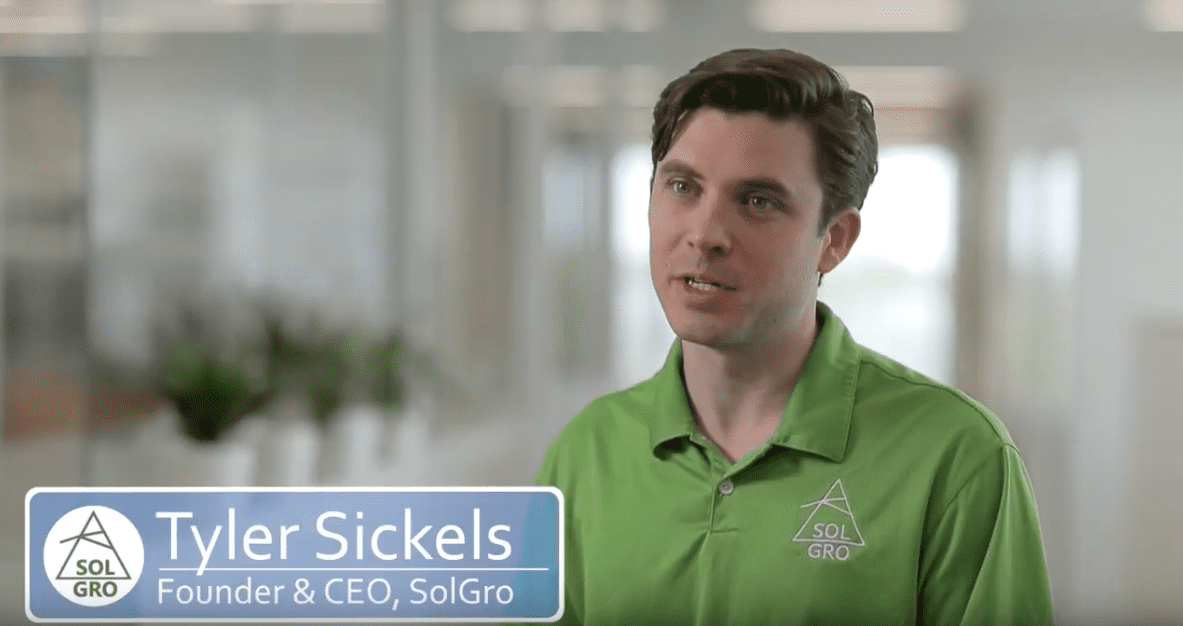Meet Our IN2 Cohort: SolGro
The Donald Danforth Plant Science Center is partnering with Wells Fargo and the National Renewable Energy Laboratory to participate in the Wells Fargo Innovation Incubator, IN2. The first ag cohort of companies will collaborate with our Principal Investigators to test their technologies. We will be sharing the stories behind these companies in a blog series throughout the summer.
Sunlight is the energy source that powers most life on earth. Through photosynthesis, organisms called photoautotrophs capture and convert light energy into chemical energy. Photoautotrophs include plants, green algae, and cyanobacteria. Most photoautotrophs are well adapted for using specific parts of the sunlight spectrum to grow, while forgoing other parts of the spectrum including ultraviolet and green wavelengths. But what if sunlight could be transformed into forms of light that plants could use more efficiently? SolGro is testing an answer to that question, with the hopes of commercializing a technology to accomplish such an improvement.
SolGro’s team aims to make controlled environment farming more efficient, giving growers the power to use fewer resources to grow more and better plants. They are commercializing embedded nano-materials into glazing for grow houses that converts more of the natural sunlight received by plants into usable forms, improving photosynthesis efficiency and increasing plant growth. This technology has the potential to help farmers decrease harvest time, increase crop yields, and improve the overall quality of their produce.
Tyler Sickels, SolGro’s founder, comes from an entrepreneurial family. He helped his father launch multiple automation technology startups for the oil and gas industry. Through the technology transfer office at the University of Texas, Arlington, Tyler met professor Wei Chen and postdoctoral fellow Sunil Sahi and invited Sunil to join the founding team at SolGro. Tyler, SolGro’s CEO and serial entrepreneur has experience taking a lab scale technology, designing business processes, and building a team to bring the technology to market. Sunil is a material scientist/chemist who spearheads technology transfer and implementation. Together, the team sees a huge potential to impact plant growth and food production around the world.
While the essential idea of SolGro’s technology is proven, customers and investors want to know if converting light into wavelengths that plants like best will actually make them grow more efficiently, how much of an improvement can they expect, and if SolGro’s innovation will come at a cost which improves their profits and returns on investment. SolGro will fast-track the process of validating their technology in research at the Danforth Center by making use of fast-growing unicellular algae. These aquatic organisms employ the same photosynthetic machinery as land plants to power their growth. With algae, however, answers to these questions can be obtained within days rather than weeks, and the algae testing will generate reliable quantitative data that will provide a benchmark for success with the SolGro light conversion technology. Promising product formulations from SolGro will be tested with algae for initial validation before further testing in one of several commercially important crops whose growers are that are good customer candidates for SolGro’s technology. Quantification of the impact of SolGro products on land plant and algae growth will give SolGro more convincing details about their materials to share with potential customers and investors.
Danforth Center Principal Investigators Ru Zhang and Jim Umen will be leading the research project to validate SolGro’s technology. Ru and Jim have expertise in algal biology and the genes that control photosynthesis. They both utilize single-celled algae as a model for understanding photosynthesis and plant growth, and in addition, Ru has expertise to investigate photosynthesis in land plants. Furthermore, Ru has a long-time interest in indoor farming, while Jim’s interest is in using algae in renewable fuel production systems.
SolGro’s success will enable farmers to use controlled environments more efficiently to produce nutritious food in greater quantities while using more available sunlight and reducing dependency on energy-consuming artificial lighting. As the global population grows and available resources grow scarcer, a technology like SolGro’s has the potential to make a huge impact on the future of plant science, agriculture, and the environment.
